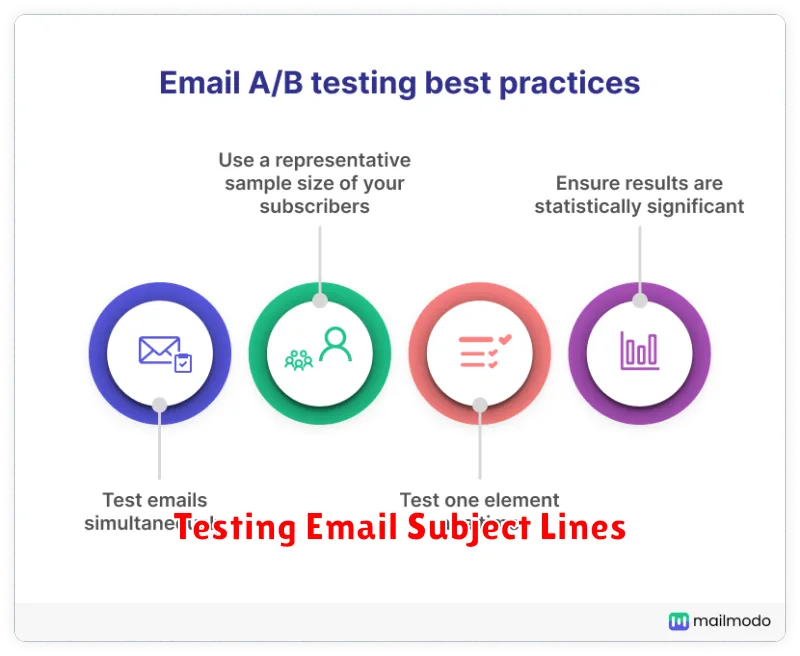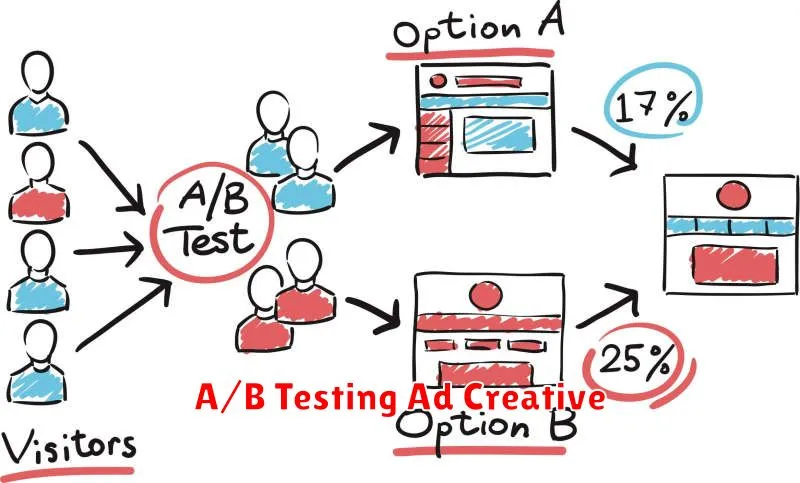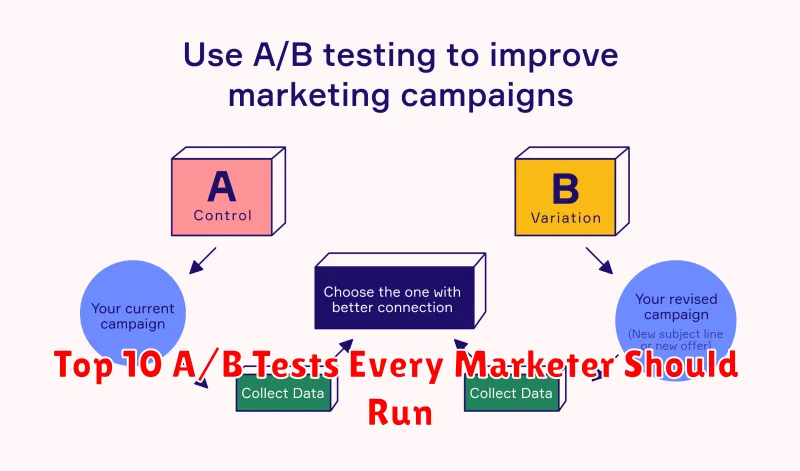A/B testing is a critical component of any successful marketing strategy. By systematically comparing two versions of a webpage, email, or advertisement, marketers can gain valuable insights into user behavior and optimize their campaigns for maximum impact. This data-driven approach allows for informed decision-making, minimizing guesswork and maximizing return on investment (ROI). Whether you are focused on increasing conversion rates, improving click-through rates, or boosting engagement, A/B testing provides the essential framework for continuous improvement and achieving your marketing objectives. Embarking on a well-structured A/B testing journey can significantly enhance your marketing performance and propel your business forward.
This article will explore the top 10 A/B tests every marketer should run to optimize their marketing efforts and achieve significant results. From headlines and calls to action to email subject lines and landing page layouts, we will delve into the key elements that can be tested to enhance user experience, drive conversions, and ultimately, boost your bottom line. Understanding the power of A/B testing and implementing these essential tests can be the difference between a mediocre campaign and a highly successful one. Read on to discover the critical A/B tests that can transform your marketing strategy.
Testing Email Subject Lines

One of the most impactful A/B tests you can run as a marketer revolves around email subject lines. A compelling subject line is the key to getting your emails opened. Even the best email content is worthless if it sits unread in the inbox.
Test different approaches to see what resonates best with your audience. Consider variations in:
- Length: Short and sweet vs. more descriptive.
- Keywords: Highlighting key benefits or offers.
- Personalization: Using the recipient’s name or other relevant data.
- Tone: Urgent, playful, or formal.
- Emojis: Using emojis (use sparingly and test carefully).
By testing these elements, you can identify the optimal subject line to maximize your open rates and ultimately, the success of your email marketing campaigns. Small changes can make a big difference.
Comparing Call-to-Action Phrases
A strong call-to-action (CTA) is crucial for conversions. Subtle changes in phrasing can significantly impact results. This A/B test focuses on identifying the most effective wording to encourage desired actions.
For example, you might test variations like “Shop Now” versus “See Our Collection” or “Get Started Today” versus “Try it Free“. Tracking click-through rates and conversions for each variation helps determine which resonates best with your audience.
Consider testing CTAs with differing levels of urgency, exclusivity, or benefit-driven language. A simple change from “Learn More” to “Discover the Benefits” could yield surprising results.
Remember to maintain consistency in design and placement of your CTAs across variations so the test solely isolates the impact of the phrasing itself.
Changing Button Colors and Placement
Button clicks are a key performance indicator (KPI) for many online marketing campaigns. Slight alterations to button attributes can have a significant impact on conversion rates. Therefore, A/B testing different button colors and placements is crucial.
Color Psychology: The color of a button can influence user behavior. For example, a green button might convey a sense of security and progression, while a red button might create a sense of urgency.
Placement Considerations: Button placement is equally important. A button placed above-the-fold might receive more clicks than one buried at the bottom of the page. Consider testing different placements, such as within the hero section, near product descriptions, or at the end of a form.
Test Variations: Some common button variations to test include:
- Different shades of the same color (e.g., light blue vs. dark blue)
- Contrasting colors (e.g., red vs. green)
- Different button shapes (e.g., rounded vs. square)
- Varying button sizes
By analyzing the results of these tests, marketers can optimize their calls to action for maximum effectiveness.
Testing Page Headlines
Your headline is the first, and sometimes only, impression you make on a potential customer. Testing different headlines is crucial for optimizing your conversion rates. A slight change in wording, tone, or length can significantly impact how many visitors continue reading.
Consider testing variations that include:
- Numbers or Statistics: “5 Ways to Improve Your Marketing” vs. “Improve Your Marketing Today”
- Questions: “Is Your Marketing Strategy Effective?” vs. “The Ultimate Marketing Strategy Guide”
- Strong Adjectives/Verbs: “Discover Powerful Marketing Secrets” vs. “Learn About Marketing”
- Benefit-Oriented Language: “Increase Your Sales by 50%” vs. “Marketing Solutions for Businesses”
By analyzing the results of these A/B tests, you can determine which headlines resonate most with your target audience and drive the desired action.
A/B Testing Ad Creative

A/B testing your ad creative is crucial for optimizing campaign performance. This involves testing different versions of your ads to determine which resonates most effectively with your target audience. By making small, iterative changes, you can identify winning combinations that drive improved results.
Key elements to consider testing include:
- Headline: Test different phrasing, lengths, and keywords.
- Body copy: Experiment with various calls to action, benefit statements, and overall messaging.
- Imagery/Video: Compare the performance of different visuals, including photos, illustrations, and video formats.
- Layout: Explore variations in the arrangement of elements within your ad.
By analyzing the performance data from your A/B tests, such as click-through rates (CTR), conversion rates, and cost per conversion, you can make data-driven decisions to refine your ad creative and maximize your return on investment.
Testing Landing Page Layouts
A landing page’s layout significantly impacts conversion rates. Testing different layouts helps identify which arrangement of elements resonates most effectively with your target audience. This involves experimenting with the placement of key elements like your headline, call-to-action, form fields, and supporting content.
Consider testing variations such as single-column versus two-column layouts, the position of your CTA above or below the fold, and the impact of visual hierarchy. Small changes can make a big difference. For example, relocating the form or shortening it might drastically improve conversions.
Gathering data on user interaction through heatmaps and scroll maps can inform your layout choices. Analyze where visitors are clicking, scrolling, and spending their time to understand how they navigate your page. This data helps identify potential pain points and opportunities for improvement.
Experimenting With Product Descriptions
Product descriptions directly influence purchasing decisions. Testing different versions can reveal what resonates best with your target audience.
Consider experimenting with the following elements:
- Length: Compare concise descriptions against more detailed ones.
- Tone: Test a formal tone versus a more casual and engaging approach.
- Features vs. Benefits: Highlight technical specifications or focus on how the product improves the customer’s life.
- Keywords: Incorporate relevant keywords for search engine optimization (SEO) and observe their impact on conversions.
By analyzing the performance of different product descriptions, you can identify the most effective approach for driving sales.
Timing Email Sends
Email send time is a critical factor influencing open and click-through rates. A slight adjustment can significantly impact your campaign’s success. This A/B test focuses on determining the optimal time to reach your target audience.
Version A could be your current send time, acting as the control. Version B should test a different time of day or day of the week. For example, if you typically send emails on Tuesday mornings, Version B might be Thursday afternoons.
Track key metrics like open rates, click-through rates, and conversions for each version. Analyze the results to determine which send time yields the best engagement. Remember to consider your target audience’s demographics and habits when choosing test times.
Testing Navigation Menus
Navigation is a critical element of user experience. A confusing or inefficient menu can lead to frustration and ultimately, lost conversions. Testing different navigation structures allows you to identify which layout best guides users to their desired destinations.
Consider testing variations such as:
- Mega menus vs. dropdown menus: Evaluate if a mega menu’s expansive view improves findability compared to a traditional dropdown.
- Label changes: Experiment with different wording for menu items. Is “Shop” clearer than “Products,” or vice versa?
- Placement and hierarchy: Does moving a key category higher in the menu increase engagement?
- Mobile navigation patterns: Test hamburger menus, tab bars, and other mobile-specific navigation designs.
By analyzing metrics such as bounce rate, time on site, and conversion rates, you can identify the navigation structure that optimizes user experience and drives business goals.
Comparing Different Offers
This A/B test focuses on identifying which offer resonates most effectively with your target audience. By presenting different offers to separate groups, you can gain valuable insights into customer preferences and optimize your conversion rates. Offer variations can include different pricing models, promotional discounts, bundled packages, or even variations in the framing and presentation of the core offer.
Consider testing variations such as:
- Percentage discount vs. fixed amount discount: Determine whether a 20% discount or a $20 discount is more appealing.
- Free shipping vs. discounted price: Understand the impact of free shipping on conversions compared to a slightly lower price.
- Single product vs. bundled offer: Evaluate if offering a bundled deal of related products increases average order value.
By analyzing the conversion rates and other relevant metrics for each variation, you can confidently select the offer that drives the most desirable outcomes for your business.

